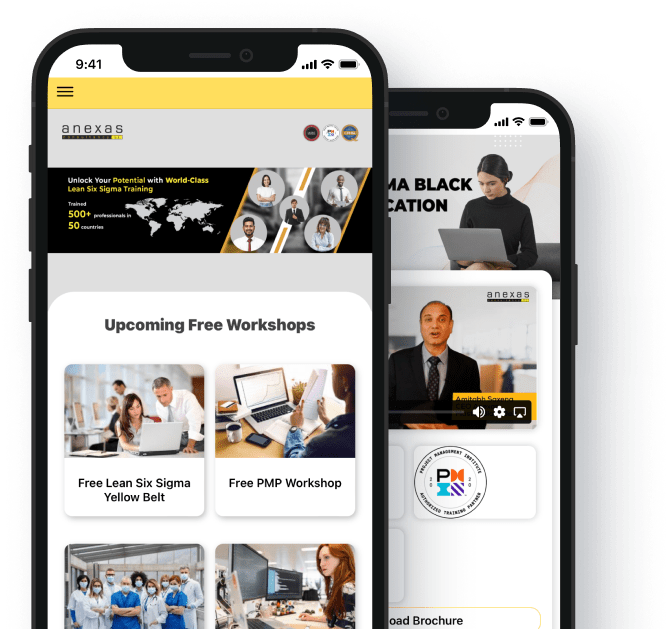Table of Contents
Share This Article
A Comprehensive Guide to Design for Six Sigma (DFSS)
- 27916 views
Introduction to Design for Six Sigma (DFSS)
Lean Six Sigma methodologies represent a powerful approach to continuous improvement within organizations, blending the principles of Lean manufacturing and Six Sigma quality management. Lean focuses on the elimination of waste and the maximization of value for the customer, while Six Sigma aims to reduce variation and defects in processes to enhance quality and efficiency. This hybrid methodology has been widely adopted across industries due to its proven ability to drive significant improvements in performance, customer satisfaction, and profitability.
Brief Overview of Lean Six Sigma
Lean Six Sigma integrates the lean principles of identifying value, streamlining processes, and eliminating waste with the statistical rigor of Six Sigma to create a comprehensive framework for process improvement. It originated in manufacturing but has since been applied successfully in service industries, healthcare, and beyond. The DMAIC (Define, Measure, Analyze, Improve, Control) methodology of Six Sigma provides a structured approach for problem-solving and process optimization, while Lean tools such as Value Stream Mapping (VSM), 5S methodology, and Just-In-Time (JIT) production complement these efforts by focusing on efficiency and waste reduction.
Importance of Design for Six Sigma (DFSS) and Lean Thinking in Continuous Improvement
In the landscape of continuous improvement, Design for Six Sigma (DFSS) and Lean Thinking play pivotal roles in ensuring sustainable and holistic enhancements. DFSS extends beyond the traditional DMAIC approach by emphasizing proactive design considerations to meet customer needs and minimize defects from the outset. By integrating Voice of the Customer (VOC) analysis, Quality Function Deployment (QFD), Failure Mode and Effects Analysis (FMEA), and Design of Experiments (DOE), DFSS enables organizations to develop robust products and processes that align closely with customer expectations. Meanwhile, Lean Thinking principles, including Value Stream Mapping, Just-In-Time production, and Kaizen, provide a complementary perspective by focusing on the elimination of non-value-added activities and the optimization of workflow efficiency. Together, DFSS and Lean Thinking foster a culture of innovation, continuous improvement, and customer-centricity, driving organizations towards operational excellence and competitive advantage in today’s dynamic business environment.
Fundamentals of Design for Six Sigma (DFSS)
In the realm of Lean Six Sigma, Design for Six Sigma (DFSS) serves as a proactive approach to ensure that products and processes are designed to meet customer requirements and achieve high levels of quality from the outset
Definition and Principles of DFSS
DFSS is a systematic methodology that focuses on designing products, services, and processes that are inherently robust and capable of meeting customer needs and expectations. Unlike the DMAIC approach, which primarily deals with improving existing processes, DFSS is concerned with creating new designs or redesigning existing ones to optimize performance and minimize variation. The core principles of DFSS revolve around understanding customer needs, translating those needs into measurable requirements, and integrating them into the design process to deliver products or services that consistently meet or exceed customer expectations.

Key Components of DFSS Methodology
- Voice of the Customer (VOC): VOC analysis involves capturing and analyzing the preferences, needs, and expectations of customers to identify critical characteristics and features that drive customer satisfaction. By understanding the VOC, organizations can align their design efforts with customer requirements from the outset, ensuring that the end product or service delivers maximum value.
- Quality Function Deployment (QFD): QFD is a structured approach that translates customer needs into specific design characteristics and engineering specifications. It facilitates cross-functional collaboration by linking customer requirements with internal processes and capabilities, enabling organizations to prioritize design features based on their impact on customer satisfaction and business objectives.
- Failure Mode and Effects Analysis (FMEA): FMEA is a proactive risk management tool that identifies potential failure modes within a design or process, assesses their potential impact on performance, and prioritizes corrective actions to mitigate risks. By systematically analyzing failure modes and their potential consequences, organizations can design robust solutions that minimize the likelihood of defects and failures.
- Design of Experiments (DOE): DOE is a statistical technique used to systematically explore and optimize design parameters to achieve desired performance outcomes. By conducting controlled experiments and analyzing the effects of various factors on the design output, organizations can identify the optimal settings for key variables and develop robust designs that are resilient to variations in process conditions.
- Robust Design: Robust design principles aim to create products and processes that are insensitive to variation and external influences, thereby ensuring consistent performance and reliability under diverse operating conditions. By incorporating robust design techniques such as parameter design, tolerance optimization, and Taguchi methods, organizations can minimize the impact of variability and improve the overall quality and reliability of their products or processes.
Comparison with DMAIC Methodology
While both DFSS and DMAIC are integral parts of the Lean Six Sigma framework, they differ in their focus and application. DMAIC is primarily used for improving existing processes by identifying and eliminating defects, reducing variation, and enhancing process efficiency and effectiveness. In contrast, DFSS is geared towards designing new products, services, or processes that meet customer needs and quality standards right from the outset. While DMAIC is reactive and problem-solving oriented, DFSS is proactive and preventive, aiming to avoid defects and errors by designing quality into the product or process from the beginning. Additionally, DFSS typically involves a more comprehensive and structured approach to design, incorporating specific tools and methodologies such as VOC analysis, QFD, FMEA, DOE, and robust design techniques to ensure the successful development of innovative and high-quality solutions.
Lean Thinking Principles
Lean thinking principles form the backbone of operational excellence, emphasizing the relentless pursuit of waste reduction, process efficiency, and continuous improvement.
Understanding Lean Principles
Lean principles encompass a set of philosophies and practices aimed at streamlining processes, eliminating waste, and optimizing value delivery to customers. These principles are instrumental in fostering a culture of continuous improvement and empowering organizations to achieve operational excellence.
- Value Stream Mapping (VSM): Value Stream Mapping is a visual tool used to analyze and improve the flow of materials and information through a process. By mapping out the current state and identifying areas of waste and inefficiency, organizations can develop future state maps that outline optimized processes and value-added activities. VSM enables cross-functional teams to collaborate effectively, identify improvement opportunities, and implement targeted solutions to enhance process efficiency and customer satisfaction.
- Just-In-Time (JIT) Production: JIT is a production strategy aimed at minimizing inventory levels and production lead times by synchronizing production with customer demand. By producing only what is needed, when it is needed, and in the right quantity, organizations can reduce waste associated with overproduction, excess inventory, and waiting time. JIT promotes flexibility, responsiveness, and efficiency in manufacturing operations, enabling organizations to deliver high-quality products to customers quickly and cost-effectively.
- Kaizen: Kaizen, often referred to as continuous improvement, emphasizes the incremental and systematic improvement of processes, products, and services. It involves empowering employees at all levels of the organization to identify and implement small-scale improvements on a continuous basis. Through Kaizen events, brainstorming sessions, and problem-solving techniques, organizations can cultivate a culture of innovation, collaboration, and ownership, driving sustainable improvements in quality, productivity, and customer satisfaction over time.
- 5S Methodology: The 5S methodology, derived from five Japanese terms—Sort, Set in Order, Shine, Standardize, and Sustain—is a systematic approach to workplace organization and cleanliness. By implementing 5S principles, organizations can create a visual workplace that promotes efficiency, safety, and productivity. Sorting involves removing unnecessary items and organizing the workspace, while Set in Order ensures that tools and materials are arranged for easy access and retrieval. Shine focuses on cleaning and maintaining the workplace, while Standardize establishes procedures and guidelines for sustaining 5S practices. Sustain involves creating a culture of discipline and accountability to ensure that 5S principles are consistently applied and maintained over time.
Integration of Lean Principles with DFSS
Integrating Lean principles with Design for Six Sigma (DFSS) enhances the effectiveness of both methodologies, enabling organizations to develop innovative products and processes that are not only robust and reliable but also efficient and waste-free. By incorporating Lean tools such as Value Stream Mapping, Just-In-Time production, Kaizen, and 5S methodology into the DFSS framework, organizations can streamline the design process, identify and eliminate waste, and optimize value delivery to customers from the outset.
Case Studies Demonstrating Lean Success Stories
Numerous case studies across various industries illustrate the transformative impact of Lean principles on organizational performance and competitiveness. From manufacturing and healthcare to service industries and beyond, organizations have leveraged Lean methodologies to achieve significant improvements in quality, productivity, and customer satisfaction. For example, companies like Toyota have revolutionized the automotive industry through the implementation of Lean manufacturing principles, resulting in reduced lead times, improved product quality, and enhanced customer value. Similarly, healthcare organizations have embraced Lean practices to streamline patient flow, reduce wait times, and enhance the overall quality of care. These case studies serve as inspiring examples of Lean success stories, demonstrating the potential for organizations to achieve operational excellence and sustainable growth through the adoption of Lean thinking principles.
DFSS Implementation Process
Design for Six Sigma (DFSS) implementation follows a structured methodology to ensure that products and processes are designed to meet customer needs and quality standards right from the outset, minimizing the risk of defects and errors.

Define Phase
The Define phase marks the beginning of the DFSS implementation process, where the focus is on clearly understanding customer needs, defining project goals, and establishing objectives to guide the design efforts.
Identifying Customer Needs and Requirements
In this crucial first step, organizations gather and analyze the Voice of the Customer (VOC) to identify and prioritize customer needs, preferences, and expectations. Techniques such as surveys, interviews, focus groups, and market research are employed to capture comprehensive insights into customer requirements. By understanding the VOC, organizations can ensure that the design efforts are aligned with customer expectations and market demands, laying the foundation for the development of successful products or processes.
Establishing Project Goals and Objectives
With a clear understanding of customer needs, organizations define specific project goals and objectives that reflect the desired outcomes of the design process. These goals should be SMART (Specific, Measurable, Achievable, Relevant, Time-bound) to provide a clear direction for the design team and ensure alignment with broader organizational objectives. Project goals may include targets for product performance, quality, cost, time-to-market, or other relevant metrics. By establishing clear and achievable goals upfront, organizations can focus their design efforts and resources effectively, increasing the likelihood of project success.
Measure Phase
The Measure phase is a critical stage in the DFSS implementation process, focusing on gathering data to understand the current state of processes and systems and conducting analysis to identify opportunities for improvement.
Gathering Data to Understand Current State
In this initial step of the Measure phase, organizations collect relevant data and information to gain insights into the current state of processes and systems. This may involve gathering data on process inputs, outputs, performance metrics, and key performance indicators (KPIs) to assess the effectiveness and efficiency of existing processes. Data collection methods may include direct observation, data mining, surveys, interviews, and process documentation. By systematically collecting and analyzing data, organizations can gain a comprehensive understanding of the strengths, weaknesses, and areas for improvement within their current processes, providing a solid foundation for subsequent analysis and improvement efforts.
Analysis of Existing Processes and Systems
Once data has been collected, organizations conduct a thorough analysis of existing processes and systems to identify opportunities for improvement. This analysis may involve techniques such as process mapping, root cause analysis, statistical analysis, and benchmarking to identify inefficiencies, bottlenecks, and areas of waste within the current processes. By examining process flow, cycle times, defect rates, and other performance metrics, organizations can pinpoint areas where improvements are needed to enhance quality, efficiency, and customer satisfaction. The analysis phase serves as a critical step in the DFSS implementation process, providing valuable insights and opportunities for targeted interventions to drive meaningful improvements in product or process design.
Analyze Phase
The Analyze phase is a pivotal stage in the DFSS implementation process, where organizations utilize various tools and techniques to delve deep into the data collected during the Measure phase and identify critical parameters and variables that impact product or process performance.
Utilizing Tools such as QFD and FMEA
During the Analyze phase, organizations leverage powerful tools such as Quality Function Deployment (QFD) and Failure Mode and Effects Analysis (FMEA) to systematically analyze data and identify areas of improvement. QFD is a structured approach that translates customer needs and requirements into specific design characteristics and engineering specifications. It enables organizations to prioritize design features based on their impact on customer satisfaction and business objectives, ensuring that the final product or process design aligns closely with customer expectations. On the other hand, FMEA is a proactive risk management tool that identifies potential failure modes within a design or process, assesses their potential impact on performance, and prioritizes corrective actions to mitigate risks. By utilizing QFD and FMEA in the Analyze phase, organizations can gain valuable insights into customer needs and potential failure modes, guiding the design process and reducing the likelihood of defects and errors in the final product or process.
Identifying Critical Parameters and Variables
In addition to utilizing tools such as QFD and FMEA, the Analyze phase involves identifying critical parameters and variables that have a significant impact on product or process performance. Through statistical analysis, sensitivity analysis, and design of experiments (DOE), organizations can systematically evaluate the effects of various factors on product or process outcomes and identify key variables that must be controlled or optimized to achieve desired performance targets. By identifying critical parameters and variables early in the design process, organizations can focus their design efforts on addressing the most influential factors, maximizing the likelihood of success and minimizing the risk of failure.

Design Phase
The Design phase is the heart of the DFSS implementation process, where organizations focus on developing innovative solutions that address customer needs and requirements, leveraging tools such as Design of Experiments (DOE) and prototyping to refine and validate designs.
Generating Innovative Solutions
In the Design phase, organizations harness creativity and innovation to generate solutions that address the requirements identified in the earlier phases of the DFSS process. Cross-functional teams collaborate to brainstorm ideas, explore alternative approaches, and develop innovative solutions that meet or exceed customer expectations. By encouraging divergent thinking and embracing a culture of innovation, organizations can explore a wide range of possibilities and identify novel approaches to address customer needs and challenges. The goal of this phase is to generate design concepts that are not only technically feasible but also aligned with customer preferences and business objectives, laying the foundation for successful product or process development.
Utilizing Design of Experiments (DOE)
As part of the Design phase, organizations utilize Design of Experiments (DOE) to systematically explore and optimize design parameters and variables. DOE is a statistical technique that allows organizations to conduct controlled experiments to understand how changes in design factors affect product or process performance. By systematically varying design parameters and analyzing their effects on key performance metrics, organizations can identify optimal design configurations that maximize performance and meet customer requirements. DOE enables organizations to make data-driven decisions and optimize design outcomes, minimizing the risk of defects and errors in the final product or process.
Developing Prototype Designs
In the final step of the Design phase, organizations develop prototype designs to validate and refine their concepts before full-scale implementation. Prototyping involves creating physical or virtual models of the proposed design to assess its functionality, performance, and usability. By testing prototypes in real-world conditions and soliciting feedback from stakeholders, organizations can identify design flaws, iterate on design concepts, and make necessary improvements to enhance product or process performance. Prototyping enables organizations to mitigate risks associated with design changes and validate design assumptions early in the development process, increasing the likelihood of success and minimizing costly redesign efforts down the line.
Verify Phase
The Verify phase is the final stage of the DFSS implementation process, where organizations focus on testing and validating designs to ensure they meet customer requirements and performance expectations.
Testing and Validating Designs
In the Verify phase, organizations conduct rigorous testing and validation to ensure that the proposed designs meet specified requirements and performance criteria. This may involve conducting a series of tests, experiments, simulations, or trials to evaluate the functionality, reliability, and robustness of the design under various operating conditions. By subjecting the design to real-world scenarios and stress testing, organizations can identify potential weaknesses, failure modes, and performance limitations, enabling them to make informed decisions and refine the design as necessary. Testing and validation are essential steps in the DFSS process, providing assurance that the final product or process design will meet customer needs and quality standards.
Assessing Performance against Customer Requirements
In addition to testing and validation, the Verify phase involves assessing the performance of the design against customer requirements and specifications. Organizations compare the actual performance of the design against predefined metrics, benchmarks, and key performance indicators (KPIs) to ensure alignment with customer expectations. This may involve conducting customer surveys, focus groups, or feedback sessions to gather input on the design and assess satisfaction levels. By evaluating performance against customer requirements, organizations can identify areas of improvement, address any discrepancies or deviations, and make necessary adjustments to optimize the design before final implementation.
Lean Tools and Techniques in DFSS
The integration of Lean tools and techniques into the Design for Six Sigma (DFSS) methodology enhances the efficiency, effectiveness, and value of the design process, ensuring that products and processes are optimized for quality, reliability, and customer satisfaction.
Value Stream Mapping (VSM) in Design Process
Value Stream Mapping (VSM) is a powerful Lean tool that enables organizations to visualize and analyze the flow of materials and information through the design process. By mapping out the current state of the design process, organizations can identify areas of waste, inefficiency, and non-value-added activities, enabling them to streamline workflows, improve process flow, and optimize resource utilization. VSM facilitates cross-functional collaboration and communication, allowing teams to identify opportunities for improvement, prioritize design features, and develop future state maps that outline optimized processes and value-added activities. By incorporating VSM into the design process, organizations can identify and eliminate waste, reduce lead times, and enhance overall efficiency and effectiveness, resulting in improved design outcomes and customer satisfaction.

Waste Reduction Strategies in Design Phase
Waste reduction is a core principle of Lean thinking, and organizations apply various strategies to eliminate waste and optimize value delivery throughout the design phase. Techniques such as Lean design principles, mistake-proofing (poka-yoke), and value analysis/value engineering (VA/VE) are employed to identify and eliminate waste in design processes. Lean design principles focus on simplifying designs, reducing complexity, and minimizing unnecessary features or components, while mistake-proofing techniques prevent errors and defects from occurring in the design. Value analysis/value engineering involves systematically evaluating design features and components to identify opportunities for cost reduction, performance enhancement, and waste elimination. By applying waste reduction strategies in the design phase, organizations can optimize resource utilization, improve efficiency, and deliver products and processes that are leaner, more efficient, and better aligned with customer needs and requirements.
Just-In-Time (JIT) Production in New Product Development
Just-In-Time (JIT) production principles are applied in the design phase to minimize inventory levels, reduce lead times, and synchronize production with customer demand. By adopting JIT principles such as pull systems, kanban, and small batch sizes, organizations can streamline the design process, reduce waste, and improve responsiveness to changing customer needs. JIT production in new product development ensures that resources are utilized efficiently, inventory costs are minimized, and products are delivered to market quickly and cost-effectively. By aligning production with customer demand, organizations can reduce the risk of overproduction, excess inventory, and obsolescence, resulting in leaner, more agile design processes and improved customer satisfaction.
Applying Kaizen Principles for Continuous Improvement in Design
Kaizen, or continuous improvement, is a fundamental principle of Lean thinking that emphasizes incremental and systematic improvements in processes, products, and services. In the design phase, organizations apply Kaizen principles to foster a culture of innovation, collaboration, and continuous learning. Kaizen events, brainstorming sessions, and cross-functional teams are utilized to identify opportunities for improvement, generate innovative ideas, and implement small-scale changes that drive incremental improvements in design quality, efficiency, and performance. By applying Kaizen principles in the design phase, organizations can harness the collective expertise and creativity of their teams, identify and eliminate waste, and drive continuous improvement in product and process design, resulting in higher-quality products, faster time-to-market, and increased customer satisfaction.
Robust Design and Optimization
Robust design and optimization play a crucial role in ensuring that products and processes meet performance requirements and deliver consistent results under varying conditions. By understanding the concept of robust design and employing techniques for design optimization, organizations can develop products and processes that are resilient, efficient, and capable of delivering value to customers.
Understanding the Concept of Robust Design
Robust design refers to the development of products or processes that are insensitive to variations in input parameters or environmental conditions, ensuring consistent performance and quality under diverse operating conditions. The goal of robust design is to minimize the impact of variability on product or process performance, resulting in improved reliability, durability, and customer satisfaction. Robust design principles emphasize the identification and control of critical parameters and factors that influence performance, as well as the optimization of designs to enhance resilience and stability. By implementing robust design techniques, organizations can minimize the risk of defects and failures, improve product quality, and enhance overall performance and reliability.
Techniques for Design Optimization
- Taguchi Methods: Taguchi Methods, developed by Genichi Taguchi, are a set of statistical techniques used for robust design and optimization. Taguchi Methods involve the use of orthogonal arrays and signal-to-noise ratios to identify optimal design parameters and settings that minimize variability and maximize performance. By conducting controlled experiments and analyzing the effects of various factors on design outcomes, organizations can identify robust design configurations that are resilient to variations in process conditions and external factors. Taguchi Methods enable organizations to achieve robust designs that deliver consistent performance and quality, even in the presence of uncertainty and variability.
- Response Surface Methodology (RSM): Response Surface Methodology (RSM) is a statistical technique used for modeling and optimizing complex systems and processes. RSM involves the use of mathematical models and experimental design techniques to explore the relationship between input variables and response variables and identify optimal design configurations that maximize performance and minimize variation. By systematically varying input parameters and analyzing their effects on design outcomes, organizations can develop predictive models that capture the behavior of the system and guide optimization efforts. RSM enables organizations to identify critical factors, assess interactions between variables, and optimize designs to meet performance requirements and objectives.
Balancing Trade-offs in Design Optimization
In design optimization, organizations often face trade-offs between conflicting objectives such as cost, quality, performance, and time-to-market. Balancing these trade-offs requires careful consideration of design constraints, priorities, and stakeholder preferences. Techniques such as multi-objective optimization, sensitivity analysis, and decision analysis are employed to evaluate alternative design configurations and identify the optimal trade-off solution that best meets the needs of stakeholders. By considering trade-offs in design optimization, organizations can make informed decisions, prioritize design features, and optimize designs to achieve the desired balance between competing objectives. This ensures that products and processes are optimized for performance, reliability, and cost-effectiveness, while meeting customer needs and business objectives.

Case Studies and Real-World Applications
Case studies and real-world applications provide valuable insights into the successful implementation of Design for Six Sigma (DFSS) and Lean thinking principles across various industries. These examples offer lessons learned, best practices, and strategies for overcoming challenges encountered during the implementation process.
Implementation of DFSS and Lean Thinking in Various Industries
DFSS and Lean thinking have been successfully implemented in a wide range of industries, including manufacturing, healthcare, finance, and service sectors. For instance, in the manufacturing industry, companies such as Toyota have pioneered the integration of Lean principles into their production processes, resulting in significant improvements in quality, efficiency, and customer satisfaction. Similarly, healthcare organizations have applied DFSS methodologies to optimize patient care processes, reduce wait times, and enhance the overall quality of care delivery. In the finance sector, banks and financial institutions have utilized DFSS to streamline processes, improve risk management practices, and enhance customer experience. These examples highlight the versatility and effectiveness of DFSS and Lean thinking in driving operational excellence and delivering value across diverse industries.
Lessons Learned and Best Practices
Through the implementation of DFSS and Lean thinking, organizations have gleaned valuable lessons and identified best practices for achieving success. Key lessons learned include the importance of leadership commitment and organizational culture in driving change, the need for cross-functional collaboration and stakeholder engagement, and the value of data-driven decision-making and continuous improvement. Best practices include establishing clear goals and objectives, providing adequate training and resources for employees, fostering a culture of innovation and empowerment, and leveraging technology and automation to streamline processes and improve efficiency. By adopting these lessons learned and best practices, organizations can maximize the benefits of DFSS and Lean thinking and achieve sustainable improvements in performance and competitiveness.
Challenges and Solutions Encountered in Implementing DFSS and Lean Principles
Despite their numerous benefits, implementing DFSS and Lean principles is not without challenges. Common challenges include resistance to change, lack of leadership support, limited resources and expertise, and difficulty in measuring and demonstrating return on investment. To address these challenges, organizations must proactively identify barriers to implementation and develop strategies to overcome them. Solutions may include providing training and education to build awareness and buy-in, engaging stakeholders and fostering a culture of continuous improvement, allocating resources effectively, and establishing metrics and performance indicators to track progress and measure success. By addressing these challenges and implementing solutions, organizations can overcome obstacles to implementation and realize the full potential of DFSS and Lean principles in driving organizational excellence and achieving strategic objectives.
Future Trends and Emerging Technologies
As industries evolve and technological advancements continue to reshape business landscapes, the future of Design for Six Sigma (DFSS) is intertwined with emerging trends and technologies that promise to revolutionize the way organizations approach product and process design.
Integration of DFSS with Industry 4.0 Technologies
The integration of DFSS with Industry 4.0 technologies represents a paradigm shift in the design and manufacturing landscape. Industry 4.0, characterized by the convergence of digital technologies such as the Internet of Things (IoT), artificial intelligence (AI), cloud computing, and advanced robotics, offers unprecedented opportunities for innovation and optimization throughout the product lifecycle. By leveraging these technologies, organizations can enhance data-driven decision-making, automate design processes, and create intelligent, connected products and systems. DFSS methodologies can be augmented with real-time data analytics, digital twins, and simulation tools to optimize designs, predict performance outcomes, and identify opportunities for improvement. The integration of DFSS with Industry 4.0 technologies enables organizations to design products and processes that are not only robust and reliable but also adaptable, agile, and responsive to changing market demands and customer preferences.
Predictive Analytics and Artificial Intelligence in Design Optimization
Predictive analytics and artificial intelligence (AI) are poised to revolutionize design optimization by enabling organizations to anticipate and mitigate risks, identify optimal design configurations, and accelerate innovation cycles. By harnessing the power of AI algorithms, machine learning, and predictive modeling techniques, organizations can analyze vast amounts of data to identify patterns, trends, and correlations that may not be readily apparent to human analysts. Predictive analytics enables organizations to forecast future performance outcomes, simulate different design scenarios, and optimize designs for maximum efficiency and effectiveness. AI-driven design optimization tools can automate repetitive tasks, generate design alternatives, and provide recommendations for improvement, empowering organizations to make informed decisions and drive continuous innovation. By embracing predictive analytics and AI in design optimization, organizations can reduce time-to-market, minimize costs, and deliver products and processes that exceed customer expectations.
Sustainable Design Practices and Environmental Considerations
As concerns about environmental sustainability and climate change continue to escalate, organizations are increasingly focusing on integrating sustainable design practices and environmental considerations into their product development and process design processes. Sustainable design principles, such as lifecycle assessment, eco-design, and cradle-to-cradle design, aim to minimize environmental impact, conserve resources, and promote circular economy principles. DFSS methodologies can incorporate sustainability metrics and criteria into design objectives, enabling organizations to evaluate the environmental footprint of their products and processes and identify opportunities for improvement. By adopting sustainable design practices, organizations can reduce waste, energy consumption, and greenhouse gas emissions, while enhancing product performance, durability, and longevity. Environmental considerations are becoming integral to design decision-making, driving organizations to develop innovative solutions that not only meet customer needs but also address broader societal and environmental challenges.
Conclusion
In conclusion, Design for Six Sigma (DFSS) is a powerful methodology that enables organizations to develop products and processes that are robust, reliable, and aligned with customer needs and quality standards. Throughout this exploration, we’ve delved into various aspects of DFSS, including its principles, methodologies, tools, and applications. From the initial phases of understanding customer needs and requirements to the final stages of verification and validation, DFSS provides a systematic approach to design and optimization, driving continuous improvement and innovation. Moreover, the integration of Lean thinking principles, Industry 4.0 technologies, and sustainable design practices further enhances the effectiveness and relevance of DFSS in today’s dynamic business environment. By leveraging emerging trends and technologies, organizations can optimize their design processes, minimize waste, and deliver products and processes that exceed customer expectations while addressing broader societal and environmental challenges. As industries continue to evolve and innovate, DFSS remains a cornerstone methodology for driving operational excellence, enhancing competitiveness, and achieving sustainable growth. Through its systematic approach to design and optimization, DFSS empowers organizations to create value, drive innovation, and deliver superior products and services that meet the ever-changing needs and expectations of customers and stakeholders.

FAQ
What is Design for Six Sigma (DFSS)?
Design for Six Sigma (DFSS) is a methodology used to develop new products, services, or processes that meet customer requirements and quality standards from the outset. It focuses on understanding customer needs, translating them into design requirements, and optimizing designs to minimize defects and errors.
How is DFSS different from traditional Six Sigma (DMAIC)?
While traditional Six Sigma (DMAIC) focuses on improving existing processes, DFSS is used for designing new products or processes. DFSS emphasizes proactive design optimization to ensure quality and customer satisfaction from the initial stages, whereas DMAIC is more reactive, addressing problems in existing processes.
What are the key phases of DFSS?
The key phases of DFSS typically include Define, Measure, Analyze, Design, and Verify (DMADV). Each phase involves specific activities aimed at understanding customer needs, analyzing processes, optimizing designs, and validating outcomes.
What tools are commonly used in DFSS?
Common tools used in DFSS include Quality Function Deployment (QFD), Failure Mode and Effects Analysis (FMEA), Design of Experiments (DOE), Value Stream Mapping (VSM), and statistical analysis techniques such as regression analysis and hypothesis testing.
How does DFSS contribute to customer satisfaction?
DFSS ensures that products or processes are designed to meet customer needs and expectations right from the start. By focusing on customer requirements and optimizing designs accordingly, DFSS enhances product quality, reliability, and usability, leading to increased customer satisfaction.
Can DFSS be applied in service industries?
Yes, DFSS can be applied in service industries as well. While it originated in manufacturing, DFSS principles and methodologies are applicable to any process or system where quality and customer satisfaction are paramount, including healthcare, finance, education, and hospitality.
What are the benefits of integrating Lean principles with DFSS?
Integrating Lean principles with DFSS enhances process efficiency, waste reduction, and value delivery. It promotes a culture of continuous improvement, streamlines workflows, and ensures that designs are optimized for efficiency, effectiveness, and customer value.
How does DFSS address environmental sustainability?
DFSS can incorporate sustainable design practices and environmental considerations into the design process. By minimizing waste, conserving resources, and reducing environmental impact, DFSS helps organizations develop products and processes that are environmentally friendly and socially responsible.
What are the challenges organizations may face when implementing DFSS?
Challenges in implementing DFSS may include resistance to change, lack of leadership support, limited resources or expertise, and difficulty in measuring return on investment. Overcoming these challenges requires proactive planning, stakeholder engagement, and a commitment to continuous improvement.
How can organizations measure the success of DFSS implementation?
Success in DFSS implementation can be measured by various metrics, including improvements in product quality, customer satisfaction ratings, cost savings, cycle time reduction, and return on investment. Regular performance monitoring and feedback collection help organizations gauge the effectiveness of DFSS initiatives and identify areas for further improvement.






